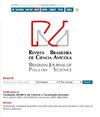Growth Curve of Brazilian Creole Chickens (Canela-Preta Breed) Raised in Two Different Rearing Systems under Tropical Climate
IF 1.1
4区 农林科学
Q3 AGRICULTURE, DAIRY & ANIMAL SCIENCE
引用次数: 0
Abstract
The objective of this study was to describe the growth curve of Brazilian Creole chickens of the Canela-Preta breed raised in two different rearing systems using non-linear growth models. A total of 400 birds were divided into two groups of 200 animals (of both genders), which were kept in confined or semi-confined systems. The confined birds were housed in an experimental masonry shed and the semi-confined animals were housed in another shed with access to pasture from 29 days of age. Birds were individually weighed every seven days during six months for determination of the growth curves of body weight using 10 non-linear models. The parameters of the models were estimated using the Gauss Newton method. The performance of the models was assessed using mean squared error (MSE), coefficient of determination (R 2 ), percentage of convergence, and residual mean absolute deviation (MAD). With the exception of the Inverse Polynomial, all the other models had R 2 values close to one. Therefore, the best models were chosen based on the lowest MSE and MAD values, with the Richards model ranking first followed by the Von Bertalanffy model. Gender and rearing system effects significantly influenced ( p< 0.05) some parameters of the Richards model. In conclusion, the Richards model was the most adequate to describe the growth of Canela-Preta chickens. Gender and rearing system significantly influenced the growth of the birds. The growth rates observed indicated that management strategies can be performed to increase the production efficiency of Canela-Preta chickens热带气候下两种不同饲养方式下巴西克里奥尔鸡(Canela-Preta品种)的生长曲线
本文章由计算机程序翻译,如有差异,请以英文原文为准。
求助全文
约1分钟内获得全文
求助全文
来源期刊

Brazilian Journal of Poultry Science
农林科学-奶制品与动物科学
CiteScore
1.80
自引率
9.10%
发文量
60
审稿时长
>12 weeks
期刊介绍:
A Revista Brasileira de Ciência Avícola surgiu em 1999 a partir da necessidade que a comunidade científica possuía de um periódico para veiculação e publicação de seus trabalhos, com a publicação de três números anuais.
A Revista conta hoje com um corpo editorial altamente qualificado e com artigos científicos desenvolvidos pelos maiores especialistas da área, o que a cada dia atrai mais leitores em busca de inovação e respaldo técnico.
Devido à credibilidade que conquistou pelos esforços de sus autores, relatores e revisores, a Revista ganhou caráter de coleção, sendo consultada como fonte segura de estudo desenvolvidos na Avicultura.
A partir de 2003 – volume 5 -, a Revista passou a chamar-se Brazilian Journal of Poultry Science, e todos os trabalhos passaram a ser publicados em inglês. No mesmo ano subiu para quatro o número de revistas por volume, ampliando-se assim os trabalhos publicados anualmente.
 求助内容:
求助内容: 应助结果提醒方式:
应助结果提醒方式:


